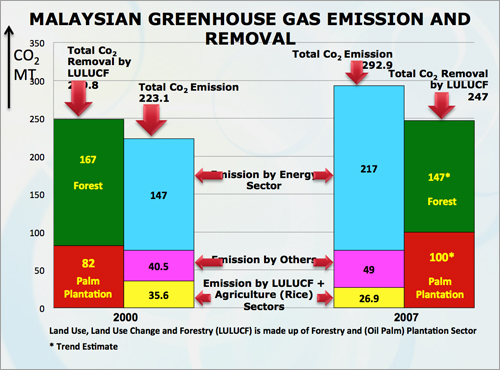CO2 REMOVAL THROUGH OIL PALM PLANTATIONS CONTRIBUTES SIGNIFICANTLY TO MALAYSIA'S CARBON SINK STATUS
Malaysia is a signatory to the United Nations Framework Convention on Climate Change (UNFCCC). As a party to UNFCCC, Malaysia has agreed to periodically report on its national greenhouse gas (GHG) emissions and measures taken to address climate change. The Initial National Communication was submitted to UNFCCC in July 2000. In January 2011, Malaysia submitted its Second National Communication (often referred to as nc2).
The GHG inventory in the Second National Communication showed that Malaysia’s GHG emission was 223 Mt CO2 eq in 2000 while the nation’s CO2 removal was 250 Mt CO2 eq. Hence, Malaysia was a net carbon sink (-27 Mt CO2 eq) in 2000.
Among the 106 countries which reported their GHG inventories to UNFCCC, Malaysia was ranked as 101, qualifying among the lowest GHG emitters in the world. USA, EU and Australia ranked among the top 20 countries with the largest CO2 emitters. Only 11 countries stood out as net carbon sinks; Malaysia was one of these.

Figure 1: GHG emission and removal sources for Malaysia in 2000 and 2007 (Source: nc2 and MPOC)
For Malaysia, permanent forest reserves and oil palm plantations were the key sectors that contributed to the country’s net carbon sink status. In 2000, the primary sources of CO2 removal was derived from forests with 167 Mt CO2 eq and oil palm plantations with 82 Mt CO2 eq (Figure 1). In 2007, oil palm plantations and forests were still the two primary CO2 removers for Malaysia. This trend will continue into the future since Malaysia has pledged to retain at least 50% of its land mass under forest and oil palm will continue to be a mainstay of the Malaysian economy.
Oil palm plantations are capable of removing as much CO2 as forest. Results in Table 1 show that the average net CO2 assimilation of oil palm is 48.8 t CO2 /ha/yr while that for a Malaysian forest is 42.4 t CO2 /ha/yr.
Table 1: Calculated gross assimilation, net assimilation and respiration of forest and oil palm stands (Source :Henson,1999)
| Forest (Pasoh) | Oil palm | |||
| Case study | National average | |||
|
Gross assimilation (t CO2 /ha/yr) |
163.5 |
161.0
|
97.9
|
|
|
Total Respiration (t CO2 /ha/yr) |
121.1 |
96.5
|
64.7
|
|
|
Net assimilation (t CO2 /ha/yr) |
42.4 |
64.5
|
33.2
|
|
The oil palm is perennial in nature and has an economic life span of 25 to 30 years. As a matter of fact, 5 million hectares of oil palm land present in Malaysia in 2012 form a green cover and act as a green sponge taking in CO2 and returning oxygen back into the atmosphere. Due to its long economic life, at any point of time, only about 4% of the oil palm area have exceeded their economic life span and are, then, felled and replanted. As the period when the old oil palms are felled and new oil palms are planted is relatively short ( with land left barren for 1-3 months only), it is no wonder that, the oil palm can contribute to Malaysia’s carbon balance in a very positive way.
Recommended reading:
1.Henson I.E. 1999. Comparative ecophysiology of oil palm and tropical rain forest.IN Gurmit S., Lim K.H., Teo L., David Lee K (editors) Oil palm and the environment, Malaysian Oil Palm Growers Council, 9-39.
2. Ministry of Natural Resources and Environment Malaysia. 2001. MALAYSIA Second National Communication to the UNFCCC, pp115.
3. Parker,L and J. Blodgett .2008. Greenhouse Gas Emissions: Perspectives on the top 20 emitters and developed versus developing nations, Congressional Research Service, pp 22.
Article Credit: Dr. F.K. Yew
Senior Fellow, MPOC

